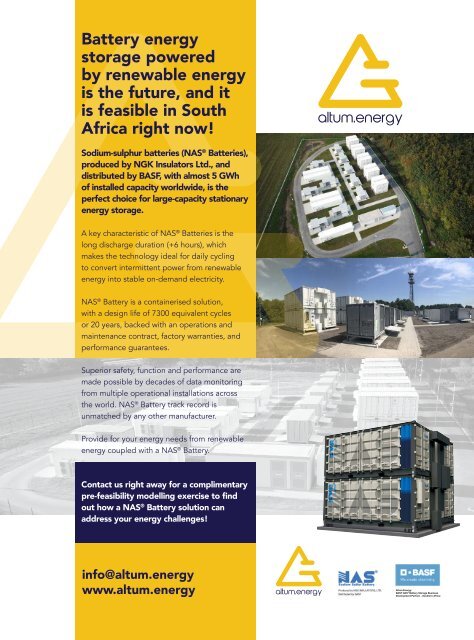+IMPACT MAGAZINE ISSUE 23
You also want an ePaper? Increase the reach of your titles
YUMPU automatically turns print PDFs into web optimized ePapers that Google loves.
Battery energy<br />
storage powered<br />
by renewable energy<br />
is the future, and it<br />
is feasible in South<br />
Africa right now!<br />
BOXA Possibilities<br />
MATERIALS<br />
Sodium-sulphur batteries (NAS ® Batteries),<br />
produced by NGK Insulators Ltd., and<br />
distributed by BASF, with almost 5 GWh<br />
of installed capacity worldwide, is the<br />
perfect choice for large-capacity stationary<br />
energy storage.<br />
A key characteristic of NAS ® Batteries is the<br />
long discharge duration (+6 hours), which<br />
makes the technology ideal for daily cycling<br />
to convert intermittent power from renewable<br />
energy into stable on-demand electricity.<br />
NAS ® Battery is a containerised solution,<br />
with a design life of 7300 equivalent cycles<br />
or 20 years, backed with an operations and<br />
maintenance contract, factory warranties, and<br />
performance guarantees.<br />
Superior safety, function and performance are<br />
made possible by decades of data monitoring<br />
from multiple operational installations across<br />
the world. NAS ® Battery track record is<br />
unmatched by any other manufacturer.<br />
Provide for your energy needs from renewable<br />
energy coupled with a NAS ® Battery.<br />
Contact us right away for a complimentary<br />
pre-feasibility modelling exercise to find<br />
out how a NAS ® Battery solution can<br />
address your energy challenges!<br />
info@altum.energy<br />
www.altum.energy<br />
Altum Energy:<br />
BASF NAS ® Battery Storage Business<br />
Development Partner – Southern Africa<br />
Boshoff Muller (Afrimat Hemp)<br />
have predictable char rates, they offer great options for<br />
off-site prefabrication, and bank finance is available for<br />
building with them.<br />
Boshoff Muller is the managing director of Cape<br />
Town-based Afrimat Hemp, which is pioneering and<br />
beneficiating the industrial hemp value chain in Africa.<br />
Muller explains that hemp is arguably one of the fastest<br />
carbon dioxide (CO2)-to-biomass tools available today.<br />
Hemp absorbs significant amounts of CO2 from the<br />
atmosphere and does it in only a three- to four-month<br />
growth cycle.<br />
Lime, a more sustainable binder than cement, is<br />
added to form ‘hempcrete’. Although lime goes through<br />
a similar manufacturing process to cement, there are two<br />
fundamental differences from a sustainability point of<br />
view: lime is calcined at a lower temperature – at 950°C,<br />
versus cement at 1 400°C – and cement needs water to set<br />
and form crystals, while lime relies on carbon absorption<br />
for its setting method.<br />
According to Muller, a reputable hempcrete company<br />
claims that for every cube of hempcrete that is used, 75kg<br />
of CO2 is removed from the atmosphere. Afrimat Hemp<br />
is completing its own lifecycle assessment of the entire<br />
value chain and hopes to achieve similar verified results.<br />
He cautions teams to verify that bio-based materials are<br />
tracked to ensure that there is no green-washing.<br />
Using reclaimed or upcycled building materials, or<br />
materials with a high recycled content can also contribute<br />
to lower embodied carbon, although the processing and<br />
transport would still need to be factored in.<br />
Hempcrete blocks combine with timber<br />
structure at Zonnestraal House by Wolf<br />
and Wolf architects.<br />
Cement-free hempcrete blocks at<br />
Afrimat Hemp’s block facility.<br />
A multifunctional room showcases BOXA’s low carbon<br />
prefabricated buildings at Johannesburg’s Victoria Yards.<br />
TOUCHING THE EARTH LIGHTLY<br />
Zutari’s technical director of structural engineering Chris<br />
Greensmith explains that ultimately the goal of embodied<br />
carbon reduction is to build less, and the best way to<br />
do that would be to not build anything new at all. “We<br />
need to start by challenging the client’s brief and ask,<br />
‘Is a new building really needed?’ Philosophically, this<br />
is a conundrum in our industry because if the answer<br />
were always ‘no’, then we are all out of employment.<br />
However, by asking this, if the answer is ‘yes’, we can<br />
move more easily towards assessing the client’s actual<br />
needs. We can look to renovating existing buildings or<br />
challenge the architectural and structural designs to<br />
produce less material-heavy configurations, before we<br />
address efficiency by tackling material choices,” he says.<br />
Changes are easier and less costly at design development<br />
stage than during construction.<br />
The largest proportion of embodied<br />
carbon is usually in the main<br />
structure of a building.<br />
Once it’s established that a new building (or a renovation)<br />
is required, and the intent and scope has been defined, the<br />
design team on any project needs to start engaging with<br />
specialists and suppliers early in order to start detailing<br />
correctly from the start. Christo van der Hoven, chief<br />
Hempcrete blocks produced for the “Cape<br />
Town hemp skyscraper”, the world’s tallest<br />
hemp-based building.<br />
POSITIVE IMPACT <strong>ISSUE</strong> <strong>23</strong><br />
51

















